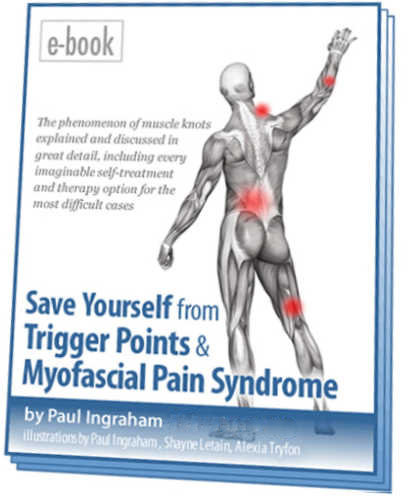Hypermobility and Ehlers-Danlos syndrome
In patients with persistent and widespread muscle pain
This is an excerpt from my book about muscle pain, so currently the page is a discussion of the relationship between the hypermobility spectrum disorders and EDS with persistent/widespread pain that seems to be muscular in nature. Here’s a quick primer on trigger points (including the controversies about them). Over time, I will change this page into a general guide to hypermobility, without the muscle focus.

Hypermobile folks usually have at least one or two obviously loose joints like this — but not all. Often these conditions have surprisingly subtle symptoms.
Some people are much more flexible than average — pathologically flexible. Hypermobile patients get hurt easily — especially repetitive strain injuries — and have a lot of chronic body pain.1 Hypermobility seems be linked to all the bafflingly stubborn, strange medically unexplained problems: fibromyalgia, chronic fatigue syndrome, temporomandibular joint syndrome, and inflammatory bowel disease.
And there’s a lot of overlap with myofascial pain syndrome here too. Hypermobility could be one of the systemic issues that drives the formation of trigger points — perhaps just due to the exhaustion caused by constantly striving to stabilize joints, or just a neurological response to pain arising from other sources. We can only speculate: this has never been studied. All my comments on the relationship between hypermobility and trigger points are just educated guesses.
Let’s get a little more specific than “hypermobility.”
There are many types of hypermobility, with a wide range of severity, from trivial “party trick” flexibility (“double-jointed”) with no apparent consequences — especially early in life — all the way to full-blown genetic disorders of the connective tissue with many serious medical consequences. There’s a huge grey zone in the middle of under-diagnosed and under-treated people, who are definitely having problems but may never figure out why or what to do about it.
Hypermobility spectrum disorders (HSD) are a group of conditions defined by joint hypermobility — unexplained joint looseness. HSD is a bucket diagnosis for people with symptomatic hypermobility, but without a connective tissue disorder that explains it, like Ehlers–Danlos syndrome or Marfan syndrome. Most connective tissue disorders are relatively obvious, but EDS can easily evade diagnosis, making it a prime suspect in many cases of chronic pain…
Ehlers–Danlos syndrome (EDS) is a closely related group of conditions with known genetic causes that includes hypermobility along with lax and fragile tissues that injure easily and heal poorly (especially skin), with many consequences. The most common form of EDS is hypermobile EDS(hEDS), and it is the only form of EDS without a known genetic cause. It’s tricky to distinguish hEDS from HSD.2 However, hEDS is probably associated with serious rheumatic diseases (i.e. psoriasis, ankylosing spondylitis, rheumatoid arthritis)… and this is fresh science and likely to be missed, “perhaps due to a lack of gravitas surrounding the hEDS diagnosis.”3
Given the musculoskeletal troubles that we know hEDS can cause, it is reasonable to guess that less severe hypermobility (HSD) may also be both clinically important and yet even less obvious.
So, hEDS/HSD is serious … but it’s not taken seriously. Even doctors who know about hEDS/HSD usually assume that it’s mostly a minor condition, and would definitely not refer patients on to a rheumatologist. And even if they did, many rheumatologists probably wouldn’t take it seriously either! They tend to be preoccupied with more obvious and dire cases.
To sum up, hypermobile-type Ehlers–Danlos syndrome (hEDS) is the most common major sub-type of EDS, a connective tissue disease without a genetic marker, which probably causes a lot of body pain but isn’t well understood and is rarely diagnosed. And if you have joint looseness that cannot be explained by hEDS or any another connective tissue disease, that might be hypermobility spectrum disorders (HSD), which is probably almost as clinically important as hEDS but even less well understood and even harder to diagnose.
Taking hypermobility seriously
Collectively, HSD/hEDS are probably quite common. If you suspect that hypermobility could be at the root of your troubles, I strongly recommend that you do some more reading and pursue a diagnosis as best you can. Hypermobility is probably one of the major possible causes of extremely stubborn myofascial pain syndrome.
Or, much worse, the idea of trigger points could be completely unrelated, a red herring. I see a lot of people get very excited about the idea/hope that trigger points explain their pain, and might be treatable. In many cases that excitement is justifiable, and relatively harmless even if it’s wrong. But it could also send someone on a long-term detour from a correct diagnosis that they really need! Trigger points are probably a commmon complication of hypermobility, and so learning to treat them probably isn’t going to be a total waste of time … but for some hypermobile patients, chasing trigger points could be a pointless, harmful distraction.
Here’s a short checklist of reasons for clinical suspicion of HSD/EDS. This is not a comprehensive diagnostic checklist … just enough to give you a sense of whether you should be looking into this more deeply, and asking your doctor to take it seriously with you:
- generally flexible, and/or “party trick” flexibility in at least one or two joints (“double-jointed”)
- too many sprains, strains, and RSIs
- too many dislocations of joints (they “pop out”)
- poor balance and/or co-ordination
- thin, stretchy skin that is easily cut and torn; stretch marks without weight gain/loss
- digestive problems like diarrhoea or constipation
- you’ve wondered and worried about diagnoses like fibromyalgia
- too many aches and pains for your age … and probably too many damn trigger points!
Obviously many people without hypermobility could check off at least a couple items on that list, and virtually every patient reading this book will at least claim the last one! But if you check off more than a couple, it’s probably time to learn more about hypermobility.

Another common sign of hypermobility is unusually stretchy skin.
Manipulating hypermobile people is risky!
Massage for people with hypermobility has the potential to do real harm. While it’s possible that cautious trigger point therapy (de-emphasizing tissue stretch) could be safe and helpful, there’s still a hazard: joints may be too unstable to manipulate. Here’s an excerpt from a funny, poignant tale of a patient with Ehlers–Danlos syndrome who was injured by a massage therapist.4 (Great illustrations, too!)
So there I am, blissed out on the massage table. Zinfandel Blush has marinated me like a chicken breast. The whales are climaxing in the background, and I’m drifting off to sleep.
She runs her oil-covered hands down my arm and gives it a gentle tug to stretch out my stiff shoulder, but it just keeps coming, until pop! It comes clean out of the socket. Dislocated.
Now I am very much awake. Zinfandel Blush is screaming. She has literally just pulled a client apart with her bare hands.
The door is flung open and the manager comes running in.
The therapist’s face is covered in tear-streaked mascara and her blonde top-knot is flailing around like my dislocated arm. The manager slams on the lights, hits the fire alarm and yells about an ambulance.
I am too preoccupied to explain that I dislocate frequently. That my jaw fell out in Costa just the other day. And that this, whilst being painful and understandably alarming to innocent bystanders, is a regular occurrence.
Obviously this patient was aware of the risk, and probably failed to warn her therapist just how vulnerable she was. (No massage therapist would ever incautiously manipulate a patient with EDS… right?!) But bear in mind that plenty of patients aren’t aware of their own condition, and halfway to an accidental dislocation is still a problem — certainly not therapeutic!
END OF FREE INTRODUCTION
To read more about trigger points, see the full trigger points tutorial, The Complete Guide to Trigger Points & Myofascial Pain. This article is just an excerpt from, one small 1,900-word chapter from a large e-book (215,000 words and 184 chapters). Buy it now or read the first few sections for free.
Paying in your own (non-USD) currency is always cheaper! My prices are set slightly lower than current exchange rates, but most cards charge extra for conversion.
Example: as a Canadian, if I pay $19.95 USD, my credit card converts it at a high rate and charges me $26.58 CAD. But if I select Canadian dollars here, I pay only $24.95 CAD.
Why so different? If you pay in United States dollars (USD), your credit card will convert the USD price to your card’s native currency, but the card companies often charge too much for conversion — it’s a way for them to make a little extra money, of course. So I offer my customers prices converted at slightly better than the current rate.
refund at any time, in a week or a year
call 778-968-0930 for purchase help
About Paul Ingraham

I am a science writer in Vancouver, Canada. I was a Registered Massage Therapist for a decade and the assistant editor of ScienceBasedMedicine.org for several years. I’ve had many injuries as a runner and ultimate player, and I’ve been a chronic pain patient myself since 2015. Full bio. See you on Facebook or Twitter., or subscribe:
What’s new in this article?
2017 — Publication.
Notes
- Scheper MC, de Vries JE, Verbunt J, Engelbert RH. Chronic pain in hypermobility syndrome and Ehlers-Danlos syndrome (hypermobility type): it is a challenge. J Pain Res. 2015;8:591–601. PubMed 26316810 ❐ PainSci Bibliography 52758 ❐ Hypermobility is “highly prevalent among patients diagnosed with chronic pain.”
- “The essential difference between HSD and hEDS lies in the stricter criteria for hEDS compared to the HSD.” But it’s very tricky, and those criteria are all very new (see the 2017 EDS International Classification).
- Rodgers KR, Gui J, Dinulos MBP, Chou RC. Ehlers-Danlos syndrome hypermobility type is associated with rheumatic diseases. Sci Rep. 2017 Jan;7:39636. PubMed 28051109 ❐ PainSci Bibliography 52757 ❐
hEDS patients may see multiple subspecialists without realizing a connection between their joint symptoms and multi-systemic involvement of the disease; they are often dismissed as hypochrondriacs, and report feelings of isolation from the lack of diagnosis.
Perhaps due to a lack of gravitas surrounding the hEDS diagnosis, management of the disease varies among practitioners, and clinical workup does not often extend beyond the joint and skin examination.
- BBC [Internet]. Clarke A. The masseuse who pulled my arm out; 2017 Aug 18 [cited 23 Apr 11]. PainSci Bibliography 53104 ❐
